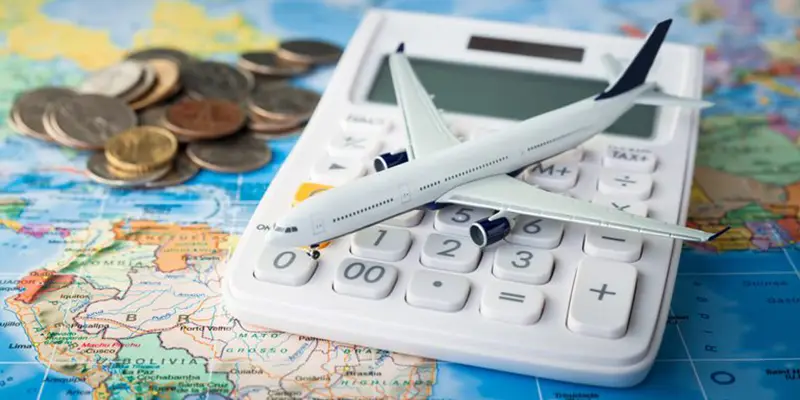The duration of a circumnavigation of the globe is contingent upon both the chosen destination and the selected mode of transportation. Illustratively, the timeframe for such a journey would significantly expand if undertaken on horseback, in stark contrast to the expedited nature of an equivalent journey undertaken via a jet aircraft. This discrepancy is primarily attributed to the vast speed differential between these two modes of transportation. Consequently, varying transportation methods will yield markedly disparate travel times.
Continue reading to learn how long it takes to travel around the world by plane, train, boat, or foot.
Distance To Be Covered During a World Trip
With an approximate diameter of 40,000 kilometers, the Earth’s measurements boast remarkable precision. This level of accuracy has its roots in the latter half of the 18th century, when it served as the foundation for establishing a unit of distance in the International System of Units. The meter was defined as one ten-millionth of the distance from the equator to the North Pole, a distance equating to approximately ten thousand kilometers. Thus, a circumnavigation of the Earth along a straight path would necessitate a journey four times this length. However, due to Earth’s oblate spheroid shape with slight polar flattening, the actual distances along the equator and meridians vary slightly. Specifically, the equatorial circumference is approximately 40,075 kilometers, while the meridians measure around 40,009 kilometers.
How Long Does It Take To Fly Around the World in a Boeing 747?

Commercial aircraft typically maintain cruising speeds that fall within the range of 500 to 700 miles per hour. Boeing’s aircraft, for example, demonstrate a maximum speed that fluctuates between 644 and 652 miles per hour, as seen in variants such as the Boeing 787 or Boeing 777. Meanwhile, the average cruising speed of a Boeing 747 is estimated at around 565 miles per hour.
In the hypothetical scenario of continuous flight, a Boeing 747-8 would require approximately 45 hours to accomplish a full circumnavigation of the Earth. A real-world example of a similar feat occurred in 1976 when a Boeing 747SP completed a round trip from New York to Delhi in a total of 47 hours. While this particular journey did not technically involve an exact circumnavigation, it did encompass a distance equivalent to the Earth’s circumference.
In ideal conditions with aerial refueling, a Boeing 747-8 operating at its maximum speed could potentially complete a global circumnavigation in around 40 hours. Should the aircraft elect to land for refueling, the necessary additional time would elevate the total journey to between 45 and 60 hours. Various factors, including weather conditions, aircraft weight, pilot skills, and the choice of starting and ending points, ultimately determine the final duration of the flight.
How Long Does It Take To Fly Around the World at Mach 20?
A continuous, uninterrupted flight around the Earth at Mach 20 – twenty times the speed of sound – would require an estimated duration of just 1 to 2 hours. On the other hand, if the aircraft maintained a speed of Mach 5 – five times the speed of sound – the circumnavigation of the globe would necessitate a lengthier span of approximately 6 to 7 hours.
Hypersonic Planes
Hypersonic aircraft, distinguished by their extraordinary speed—equivalent to five times the speed of sound—could theoretically circumnavigate the Earth in a mere 6.5 hours, given a sustained speed of 3,821 miles per hour and adequate fuel reserves for uninterrupted flight.
The epoch of hypersonic travel was heralded by Russian cosmonaut Yuri Gagarin, who became the first individual to achieve such speeds in 1961. He completed an orbit of the Earth in an astounding 108 minutes, traveling at an unprecedented velocity of 17,000 miles per hour or 27,400 kilometers per hour.
How Long Would It Take To Travel All Around the World by Train?

Embarking on a global journey via rail can promise an exhilarating adventure. The breathtaking panoramas and unique experiences gleaned from circumnavigating the world by train are undeniably extraordinary. Indeed, railway transportation is a viable option for such worldwide expeditions, with certain operators offering comprehensive tickets spanning 53 or 57 days for those with global ambitions.
Among the world’s most extensive railway services are The Blue Train, the Eastern and Oriental Express, and The Indian Pacific. These prestigious trains traverse diverse regions across the globe, offering passengers an unparalleled travel experience.
How Long Does It Take To Sail Around the World?

A nautical voyage encompassing the globe, known as a circumnavigation, typically requires between three to five years to accomplish. The record for the swiftest circumnavigation, however, stands at a mere 40 days, a feat achieved on a trimaran, thereby setting a world benchmark.
Should one choose to pursue an uninterrupted journey, pausing only for essential supply replenishment, the expedition could potentially conclude within an 80-day time frame. Such a venture is ideally suited to a racing context, as it affords only brief halts—either for addressing emergencies or fleeting moments of scenic appreciation—within its stringent schedule.
How Long Does It Take To Travel Around the World on Foot?
The Earth’s circumference measures approximately 24,902 miles. If an individual were to maintain a steady walking pace of 3 miles per hour without any intermissions, they would need approximately 8,300 hours to complete the journey. This translates to roughly 345 continuous days of walking.
How Long Would It Take To Drive Around the World?
In a hypothetical scenario where one could drive a car around the globe, it would take approximately 415 hours—just over 17 days—to traverse the Earth’s circumference of 24,900 miles. However, given the practical impossibilities of driving a car across the world’s diverse terrains and bodies of water, the actual duration required to circumnavigate the globe by road would undoubtedly be significantly lengthier.
How Much Does It Cost to Travel around the World?

Undertaking an economical circumnavigation of the globe would approximately require a budget of $30,000. The primary factor influencing this estimate is the planned duration of the journey, which significantly impacts the total expenditure. Understandably, costs will fluctuate based on personal preferences for luxury or economy in transportation.
Individuals are thus encouraged to conduct extensive research to ascertain their preferred balance within various categories—such as locale, mode of transport, accommodation, and activities—to maintain their intended budget. This also ensures they remain within their physical and psychological comfort parameters while on their global adventure.
In Conclusion
Embarking on a global sailing journey can result in an unparalleled, memorable experience. Given such an opportunity, it is highly recommended to embrace it. However, it is crucial to meticulously plan your itinerary well in advance. If, for instance, Singapore is on your voyage route, contemplate the duration of your stay, the activities you intend to partake in, and most importantly, any potential safety considerations. Wishing you an extraordinary journey!



